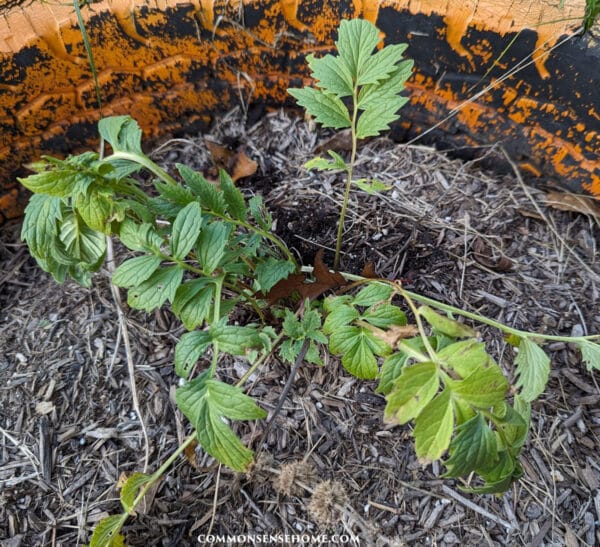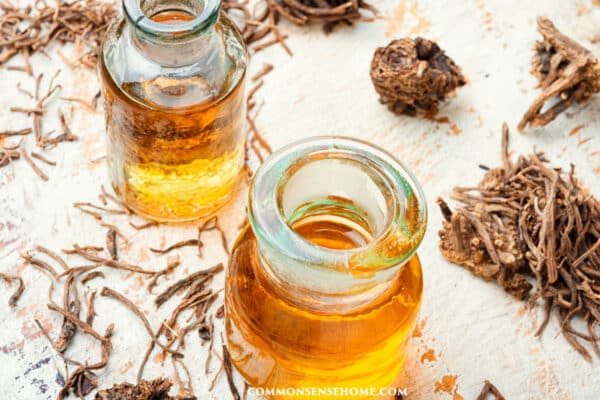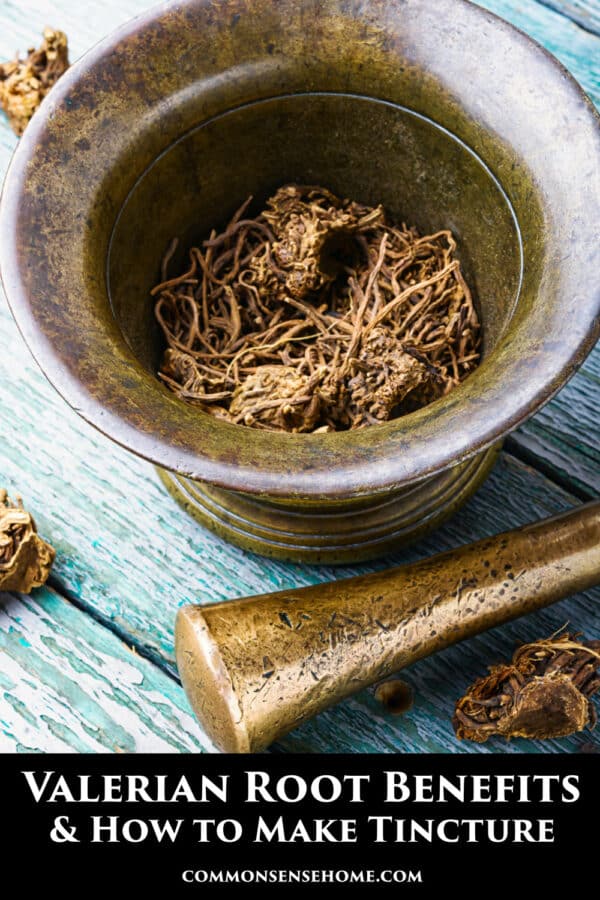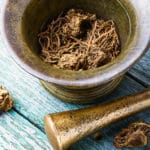How to Grow, Harvest & Use Valerian Root
Valerian root has a long history of use. It's a relaxing, “soporific” (sleep inducing) herb that has a normalizing effect on the nervous system.

Additionally, it reduces stress and loosen muscles that have tightened up with nervous tension. Valerian is also effective against tension headaches, as well as intestinal cramping as it pertains to stress. It shows promise for many female maladies as well.
We share tips on foraging, growing, use, and contraindications.
Foraging
Valerian (Valeriana officinalis) is a perennial plant naturalized to North America from Europe and parts of Asia. In the United States, it grows in moist woodlands and meadows in zones three to nine.
Valerian grows to about five to six feet tall, it has a hollow stem with divided, pinnate leaves in about seven to ten pairs. The plant produces clusters of sweet scented, pale pink/white flowers.

The root system, which is the part we use for medicine, is a vertical rhizome with smaller rootlets. Dig the roots in the fall of the second year to give them ample time to mature. The scent of the roots is quite pungent, resembling the odor of stinky socks! However, there are also herbalists who enjoy the earthy scent.
Cultivation
Valerian is easy to transplant and grow, or you can start it from seed. Dig wild valerian in the spring and transplant it to the herb garden where there is sun/part shade. It prefers moist, well-drained soil but will tolerate a wide range of conditions.
Plant seeds ⅜” deep, and keep moist and warm until germinated. Once germinated, grow in normal greenhouse conditions. Harden off the plants in the early spring, then transplant to your herb garden.
Another method is to sow the seeds directly into the soil about ⅜ -½”, either in the spring or the fall. Thin plants to 12-18” apart, and space rows of plants three feet apart.

The main plant dies back the second year, and smaller plants grow at the base. Transplant these to expand your patch. Valerian readily self-sows, and may escape captivity and become “invasive”. For stronger, thicker roots, make sure to dead-head the flowers throughout the season.
Harvesting
Harvest valerian root from second year plants, in the fall after the first frost. Spring harvested roots will not be as potent as fall roots. Plants store nutrients in their roots to sustain them through the winter; we want them before they use up those stores.
To harvest the roots, first, clear away the leaves to access the plant. With a small shovel or a hori hori, carefully dig down next to the root – get the roots, as well as the rhizomes.

The Hori Hori
The hori hori was developed in Japan for use as a sturdy gardening knife. They have both a flat edge as well as a serrated edge. They are able to saw through woody stems, which makes them great for weeding, or in our case – foraging herbal roots.
The flat edge is good for harvesting the aerial portions. When choosing a hori hori, opt for stainless steel so that it cleans easily and will not rust.
Processing Valerian Root
After digging the roots, shake off the loose dirt, and then scrub well using a vegetable brush. Do not leave your roots to soak, as they will begin to release their valuable constituents. Chop the roots into small pieces right away to either dry or process as medicine.
To dry, place into your dehydrator on the herb setting if it has one, if not set to 95 degrees F. If you do not have a dehydrator, spread your chopped roots out on a sheet pan in your oven set to 100 degrees. Be forewarned, your drying roots will waft an extremely pungent aroma.
To prepare for medicine, chop into small pieces, and tincture fresh in alcohol. Use a 1:2 ratio with 100 percent alcohol, or in 100 percent glycerin. You can use dry roots, but valerian is best if used fresh.
Valerian can also be prepared as an infusion. Most root infusions require decoction (cooking at high heat). However, valerian root is best gently steeped in a lower temperature to avoid destroying important volatile oils and constituents.
Valerian’s Historical Uses
Valerian has many uses, including filling your pockets with the fresh root to draw the rats out of town like the Pied Piper of Hamelin. At also works as a catnip alternative for your feline friends.
According to The Herbal Academy, valerian has more than 2000 years of documented use, dating back to Ancient Greece and Rome:
- Pliney (23 AD – 79 AD) recommended valerian for pain relief;
- Dioscorides (40 AD – 90 AD) used it as a diuretic;
- Galen (129 AD – 200 AD) as a decongestant;
- Hildegard of Binger (1098 – 1179, 100 years before the Pied Piper) used it as a tranquilizer and in sleep aids;
- John Gerard (1545 – 1611) touted it as an aid for chest congestion, convulsions, and bruises;
- Culpepper (1616 – 1654) claimed it was useful against the plague, but also for coughs and wounds;
- The 19th century Eclectics used it as a calmative and for epilepsy;
- During World War I and II, used as a nervine for shell shock and for calming nervous citizens.
- It was in the U.S. Pharmacopeia from 1820 – 1942; and it was
- Included in the National Formulary until 1950.
Benefits of Valerian Root
Current uses of valerian root:
- Normalizing the nervous system
- Neuroprotectant
- Anxiolytic
- Antidepressant
- Anticonvulsant
- Relaxant
- Mild sedative
- Sleep aid
- Relieves muscle tension from anxiety
- Analgesic
- Antidepressant
- Antispasmodic
- Nervine
- Antioxidant
- Relieves tension headache from stress and anxiety
Stress, Tension, and More
Valerian's sedative effects are helpful where stress, tension, and anxiety is present. It helps someone dealing with over-excitability or overstimulation to unwind and unbind.
Valerian especially targets the musculoskeletal, digestive, and cardiovascular systems where anxiety, and nervous tension are the cause. As an antispasmodic, it is effective against painful periods, and menstrual cramps. Valerian is proving to be effective against several maladies relating to menopausal, and postmenopausal women.

Studies suggest that valerian root is an effective sleep aid. One clinical study looked the effects of valerian extract for 100 postmenopausal women aged 50 to 60 years with insomnia.
The women were randomly divided into two groups. Each group received either 530 mg of concentrated valerian extract or a placebo twice a day for 4 weeks. Those treated with valerian root reported they were able to fall asleep better, with no adverse effects compared with the placebo group.
Valerian works well for pain with tension, as well as sleeplessness with tension and anxiety. It relaxes nervous tension that manifests in the stomach.
Studies show valerian to be a valuable herb for PMS, menstrual cramps, as well as menopausal and postmenopausal maladies. Combine valerian with other herbs for greater effectiveness. Presently there are no studies on the long term use of valerian root.
Helpful Combinations
Herbs are often enhanced by other herbs, or enhance other herbs. Sometimes they either soften the harsher effects of other herbs, or are softened by other herbs.
Valerian is an herb that falls into a few of those categories, and therefore combines well with several other herbs. Combine these herbs in a 2:1 herb to valerian root ratio.
- Tension – combine with skullcap and passionflower
- Uterine cramps – combine with cramp bark and black cohosh
- Insomnia – combine with passion flower and hops

Dosage
Take preparation methods into consideration for dosing valerian. The most effective active constituents, valerenic acids, are highly volatile. Dried roots have less medicinal action than fresh roots. A fresh root tincture will be stronger than a dried root tincture.
Heat also drives off the active constituents. This means that a cooler, or even cold infusion is best. Herb dosage is also dependent upon the person receiving the herb.
Some people will be more responsive to it, and some will be less sensitive, requiring a higher dosage. Start with 1 teaspoon of the dry root to 8 ounces of water for an infusion. For a tincture of either dry or fresh, use 10 drops up to 1 teaspoon; observe and adjust as needed.
Contraindications and Side Effects
In some people, valerian root produces nervous energy and anxiety instead of a calming effect. For this reason, try a small dose out before administering a full dose, especially before bed.
Valerian may cause bad dreams, most notably when taken in the evening. The simple remedy is to add passionflower in equal parts to your tincture or infusion.
Do not use valerian when driving, or operating heavy machinery. Do not take with alcohol or other drugs metabolized in the liver. This may amplify the effects of the valerian, drugs, alcohol, or all of the above. Overdose can result in sleepiness the next day, and possible headache.

The Home Apothecary Series
This article is part of the Home Apothecary series. Other articles include:
Building Your Own Home Apothecary
White Willow Bark – Harvesting and Use
Ginger Root Uses & Health Benefits
Soothing Ginger Honey – Natural Remedy for Sore Throat and Coughs
Fennel Seed – Natural Digestive Aid

This article was written by Sylvia Gunther.
Sylvia studied under Rosemary Gladstar and earned the distinction of Traditional Herbalist. She then studied Clinical Herbalism through The Herbal Academy, where she continues her life long exploration of herbs.
Sylvia and her husband live in North Central Indiana. Together they raised six beautiful children.




